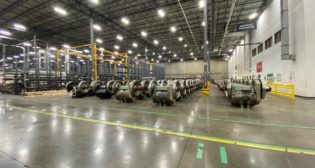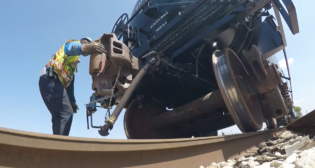
Freight car market 2013-14: Down, then up
Written by William C. Vantuono, Editor-in-ChiefEconomic Planning Associates (EPA), in its latest freight car delivery forecast, is predicting that 48,800 cars will be delivered in 2013—a 15% drop from 2012’s 57,200—followed by a strong rebound in 2014, to 60,300.
“Assuming no further jolts to our economy from either U.S. Environmental Protection Agency regulations or the Administration or external negative developments involving the financial environments abroad, we look for a stabilization in demand for most car types with the exceptions of small cube covered hoppers and coal cars,” says EPA’s Peter Toja. “After strong deliveries last year and the first half of this year, demand for these hoppers weakened considerably in this year’s first half. As a result, our estimate of an easing in assemblies of small cube equipment from 15,000 units this year to 5,000 units in 2013 as well as the pronounced weakening in coal car demand will serve to drop total railcar deliveries from 57,200 cars this year to 48,800 cars in 2013. In 2014, we look for railcar deliveries to rebound to 60,300. After 2014, annual railcar assemblies will average 66,000 to 67,000 thousand units per year out to 2017.”
Third quarter orders “reflected a modest improvement in demand for covered hoppers, mill gondolas, and class F equipment, which are auto carriers to support the increasing sales and North American production of light vehicles,” notes Toja. “By the same token, tank cars are by far the predominant car type in demand—primarily to transport oil from the Dakotas. In the second quarter, tank cars comprised 83.5% of total railcar orders. Even with improvements among a variety of other railcars, tank car orders in the third quarter still accounted for 58.3% of the total. It has become readily apparent that lacking pipeline capability, increasing amounts of Bakken oil will move by rail. And, with strong quarterly orders this year and a backlog of 46,705 cars, we have significantly raised both our short and long term outlooks on tank car deliveries.”
Though Toja is “pleasantly surprised” by the modest expansion in demand for other car types, he remains cautious. “We are concerned about the underwhelming growth of the economy as manufacturers, oil and gas producers, and coal companies struggle with the increasing number of government regulations that are dampening our economic potential,” he says. “We have noticed that GDP growth has slipped from 2.0% in the first quarter to 1.3% in the second quarter. Hopefully, our economy can eventually embark on a stronger path of growth that will improve railroad traffic, revenue, and investments leading to continued healthy growth in railcar demand.”
U.S. railroads reported that coal and agriculture were “extremely weak markets” during the third quarter,” Toja notes. “We suspect that coal will continue to underperform during the short and long term horizons. Coal movements continue to be depressed by a sluggish economy, low natural gas prices, and a hostile Environmental Protection Agency. In spite of the abundance of coal in the U.S. and industry efforts to clean up the mining and combustion sectors of the industry, the EPA continues to press for even more stringent regulations against the production and consumption of coal. Haulings are reflecting the dismal background. Through September of this year, rail coal movements were running 9.6% below the comparable period of 2011. While we had endorsed a ‘wait and see’ posture in future EPA regulations, it is apparent that the government is set to ‘go green” and squeeze the coal industry. The fact that other nations on this globe are burning our coal and releasing far greater pollutants in the atmosphere appears to be of no concern to the Administration.”
Given these circumstances, EPA has lowered its sights on coal car deliveries. However, it does anticipate some modest growth in investments for export coal equipment and replacements within very old fleets. “Stricter air emission standards will promote the use of lower sulphur western coal, which is also lower BTU value coal, leading to greater volumes of coal traveling longer distances,” Toja says. “This, in turn, should lead to some limited replacements of older, smaller, steel bodied coal cars with the larger volume aluminum gondolas and hoppers of today and tomorrow. At the same time, eastern coal fleet requirements will stimulate some demand for technologically advanced steel and hybrid coal cars.
On a more positive note, the automotive market has improved and light vehicle sales advanced 10.2% last year. In response, a significant number of auto carriers were ordered in the fourth quarter of last year and in the first three quarters of this year. “We expect these investments to be worthwhile since North American light vehicle production through September was running 19.9% ahead of the previous year,” Toja says. “The housing and construction markets should continue to stabilize as we proceed through 2012 and into 2013. Manufacturing activities will continue expanding, albeit at a more moderate pace, leading to greater movements of metals, ores, fabricated products, and a variety of chemical and petroleum products. Export markets for corn and wheat are expected to rebound in 2013, weather permitting.”
Toja believes that the covered hopper market “remains viable.” After this year, stronger production of ethanol from corn as well as a rebound in chemicals and plastics activities “will stimulate demand for hi-cube equipment while increased export volumes and greater domestic grain consumption bolster demand for midsized cars,” Toja says. “Sharply higher energy prices are stimulating oil and gas exploratory activities and a large number of the small cube cars will be destined to oil and gas field service companies as well as other sectors of construction.”
Strength in manufacturing activities and a rebound in steel demand revived orders for GB gondolas last year and in this year’s first nine months, while increased production from the Bakken Shale formation is promoting growth in small-cube covered hoppers and tank cars. “Longer term, we are hopeful that stronger economic activities will provide support for certain railcar assemblies while an improvement in the financial environment, high gasoline prices, and strong government backing stimulate greater demand for ethanol and DDG cars,” Toja says. “Replacement pressures and technological advances as well as legislative measures will also play a role in promoting the demand for a variety of railcars. Construction activities are expected to return to higher levels, which should support movements of aggregates and structural steel products. Continued expansion in demand for petroleum products, chemicals, and food and beverages will prop up the haulings of a variety of liquid products and the demand for tank cars.”
Toja calls tank cars “the most dynamic element in the long-term railcar environment,” due mainly to constantly increasing volumes of oil and petroleum products moved by rail.
“Growing worldwide nutritional needs and expanding exports will pressure the current grain service cars as we proceed through the longer term while long neglected segments such as equipment to haul waste, aggregates, and limestone show signs of revival and should add to the railcar delivery mix in the years to come,” Toja concludes.



